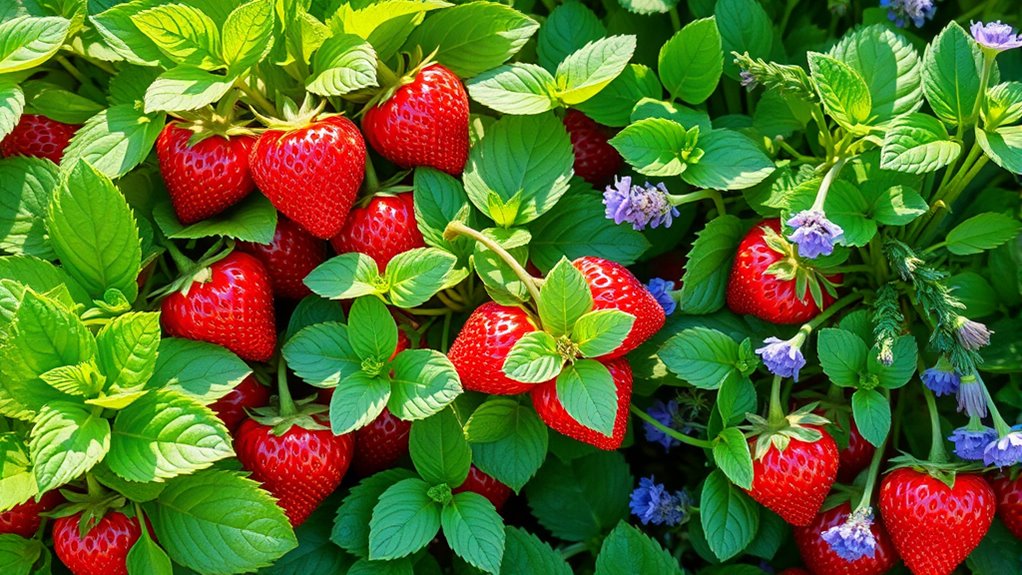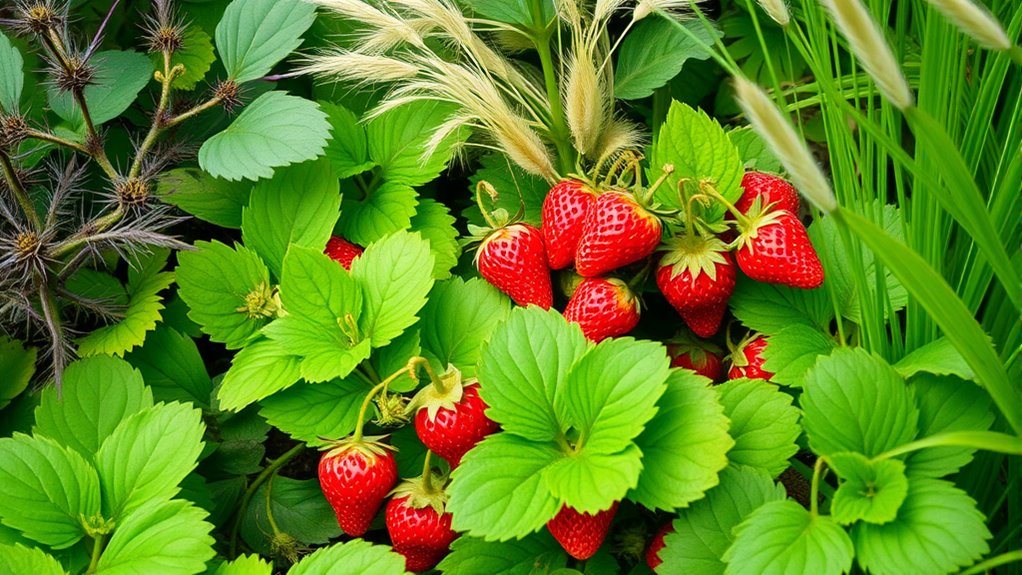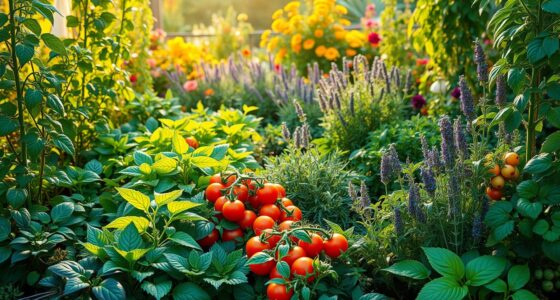To boost your strawberry garden, plant herbs like basil, chives, and mint to repel pests and enhance flavor. Flowers such as marigolds, yarrow, and dill attract beneficial insects that naturally control pests. Combine leafy greens, radishes, and beans alongside strawberries to maximize space and improve soil health. Avoid brassicas, tomatoes, and mint close to strawberries to prevent disease and competition. Keep exploring for more tips to create a thriving, pest-free strawberry patch.
Key Takeaways
- Incorporate herbs like basil, chives, and mint to repel pests and enhance strawberry flavor.
- Plant flowering plants such as marigolds, yarrow, and dill to attract beneficial insects and pollinators.
- Grow low-growing vegetables like spinach, lettuce, and radishes to utilize space without shading strawberries.
- Use plants like cilantro and dill to suppress weeds and attract pest predators, promoting garden health.
- Avoid brassicas, tomatoes, and mint that can compete with strawberries or cause disease spread.
Herbs That Complement Strawberry Growth

Herbs that complement strawberry growth can boost your garden’s productivity and health. Planting herbs like basil, chives, and mint nearby helps repel pests that threaten strawberries, such as aphids and spider mites. Basil not only deters pests but also enhances the flavor of your strawberries. Chives emit sulfur compounds that can discourage nematodes and other soil-borne pests. Mint, when contained, attracts beneficial insects and masks strawberry scents from pests, reducing damage. These herbs also improve soil health by adding organic matter and nutrients. Plus, they’re easy to grow and harvest, offering fresh flavors for your kitchen. Incorporating these herbs into your strawberry beds creates a natural pest barrier and promotes a thriving, healthy garden environment. Additionally, planting companion plants that support healthy soil and pest control can further enhance your strawberry garden’s success. Utilizing beneficial insects attracted by herbs can also naturally reduce pest populations, creating an integrated pest management system. Understanding the specific plant interactions in your garden can optimize growth and pest resistance. Incorporating soil health practices such as composting and crop rotation can further improve plant resilience and yield. Furthermore, choosing the right plant placement can maximize the benefits of companion planting strategies.
Flowers That Attract Beneficial Insects

Planting the right flowers near your strawberries can substantially boost your garden’s health by attracting beneficial insects. Flowers like marigolds, yarrow, and dill produce nectar and pollen that attract pollinators and predatory insects, such as ladybugs and lacewings. These beneficial insects help control pests like aphids and spider mites, reducing the need for chemical treatments. Bright, fragrant blooms catch the attention of these helpful bugs, encouraging them to stay and protect your strawberries throughout the growing season. Additionally, planting a variety of flowering plants ensures a continuous food source, maintaining their presence. Creating a pollinator-friendly environment by incorporating diverse flowers can further enhance this natural pest control system. Incorporating mindfulness into your gardening routine can enhance your awareness of the natural ecosystem and support sustainable practices. Understanding the importance of biological pest control can guide you in selecting the most effective companion plants for your strawberries. The presence of beneficial insects can significantly reduce pest populations naturally, fostering a healthier garden. Using integrated pest management techniques alongside planting beneficial flowers can optimize pest control efforts. By choosing flowers strategically, you create a natural pest management system that keeps your strawberries healthier and more productive. This approach promotes a balanced, eco-friendly garden environment.
Vegetables That Share Space With Strawberries

Growing strawberries alongside certain vegetables can maximize space and boost your garden’s productivity. Leafy greens like spinach and lettuce are excellent choices because they grow low and won’t shade your strawberries. Radishes and carrots also work well; they grow quickly and can be harvested early, freeing up space for your strawberries to flourish. Beans and peas are beneficial because they fix nitrogen in the soil, enriching nutrients for strawberries. Keep in mind that you should avoid planting vegetables that might compete heavily for nutrients or shade the strawberries, such as large squash or corn. By choosing vegetables that grow close to the ground or mature early, you create a symbiotic environment that benefits both crops and makes efficient use of your garden space. Incorporating companion planting principles can further optimize your garden’s health and yield. Additionally, selecting vegetables that are compatible with payment processing security can help ensure a safe and productive garden environment. Using plant compatibility data can assist in making successful pairing decisions for your garden.
Plants That Help Suppress Weeds and Pests

Integrating certain plants into your strawberry bed can naturally reduce weeds and pests, creating a healthier and more manageable garden. Herbs like basil, cilantro, and dill are excellent choices. Basil helps repel aphids and spider mites, while cilantro attracts beneficial insects that prey on pest pests. Dill attracts predatory wasps and parasitic wasps that target pests like aphids and caterpillars. Marigolds are also beneficial; their strong scent deters nematodes, beetles, and other harmful insects. These plants compete with weeds for nutrients and space, helping keep your strawberry bed clean. Additionally, they attract pollinators and beneficial insects, which support overall plant health. Incorporating companion planting can enhance pest control and improve crop yields. Using natural pest barriers like these plants reduces the need for chemical interventions and promotes a sustainable garden environment. Traditional crossbreeding techniques have been used to develop some of these beneficial plant varieties, making them effective allies in your garden. By choosing these companion plants, you create a natural pest barrier and reduce the need for chemical interventions. Incorporating plants with air purifier features and technology can further improve your garden environment by reducing airborne pollutants and allergens.
Companion Plants to Avoid Near Strawberries

Certain plants can hinder your strawberry plants’ growth or attract pests that damage them. For example, avoid planting brassicas like broccoli, cabbage, or cauliflower nearby, as they can compete for nutrients and attract pests like aphids. Mint is another culprit; while it can deter some pests, it tends to overtake strawberries, choking out other plants and making harvesting difficult. Pine or pine needles should also be kept away, as their acidity can harm strawberry roots. Additionally, avoid planting tomatoes or potatoes close by, since they can host diseases that may spread to strawberries. Be mindful of these plant choices to prevent pests and diseases, ensuring your strawberries grow healthy and productive without unnecessary interference. Maintaining proper plant spacing is essential to promote healthy growth and prevent the spread of diseases or pests.
Frequently Asked Questions
Can Strawberries Be Grown Successfully in Containers With Companion Plants?
You can definitely grow strawberries successfully in containers alongside companion plants. By choosing the right companions, you enhance pollination, deter pests, and improve growth. Make sure your container has good drainage and enough space for both strawberries and their partners. Regular watering and sunlight are essential. With proper care, your container garden will flourish, and you’ll enjoy a healthy, productive strawberry harvest alongside beneficial companion plants.
How Do Companion Plants Influence Strawberry Flavor and Fruit Quality?
Imagine your strawberries as a symphony, each note (or fruit) enhanced by the right harmony. Companion plants can boost flavor and quality by repelling pests, enriching soil, and promoting healthy growth. For example, planting basil nearby can intensify sweetness, much like adding spices to a dish. These natural alliances create a balanced environment, ensuring your strawberries develop richer, more vibrant flavors and juicier, higher-quality fruit.
Are There Specific Soil Amendments Needed When Planting Companions With Strawberries?
When planting companions with strawberries, you should consider soil amendments to support healthy growth. You might need to add organic matter like compost to improve soil fertility and drainage. Incorporate mulch to retain moisture and suppress weeds. If your soil is acidic, consider lime to balance pH. Regularly monitor soil nutrients, and adjust with balanced fertilizers as needed to guarantee your strawberries and their companions thrive together.
What Is the Ideal Planting Distance Between Strawberries and Their Companions?
Imagine planting a friendship where space nurtures growth. You should space strawberries and their companions about 12 to 18 inches apart, giving each plant room to breathe and thrive. This distance balances access to sunlight, airflow, and nutrients, preventing disease and encouraging healthy development. Think of it as a dance—each partner needs enough space to move freely, ensuring your garden blossoms with energy and harmony.
Do Companion Plants Extend the Harvesting Season for Strawberries?
Companion plants can help extend your strawberry harvest by improving plant health and warding off pests, which allows strawberries to thrive longer. As you plant beneficial companions nearby, they can provide shade, attract pollinators, and reduce disease, leading to a more sustained fruit production. Keep in mind that while they support growth, companion plants alone might not drastically lengthen the season but certainly contribute to a healthier, more productive strawberry patch.
Conclusion
By choosing the right companion plants, you’re transforming your garden into a strawberry paradise where pests vanish, weeds bow down, and beneficial insects flock to your patch like moths to a flame. Imagine your strawberries thriving like never before, producing sweeter, juicier berries while your garden becomes an unstoppable fortress of growth. With these plant allies by your side, you’ll turn your garden into the ultimate strawberry haven—more abundant and resilient than you ever dreamed possible!









